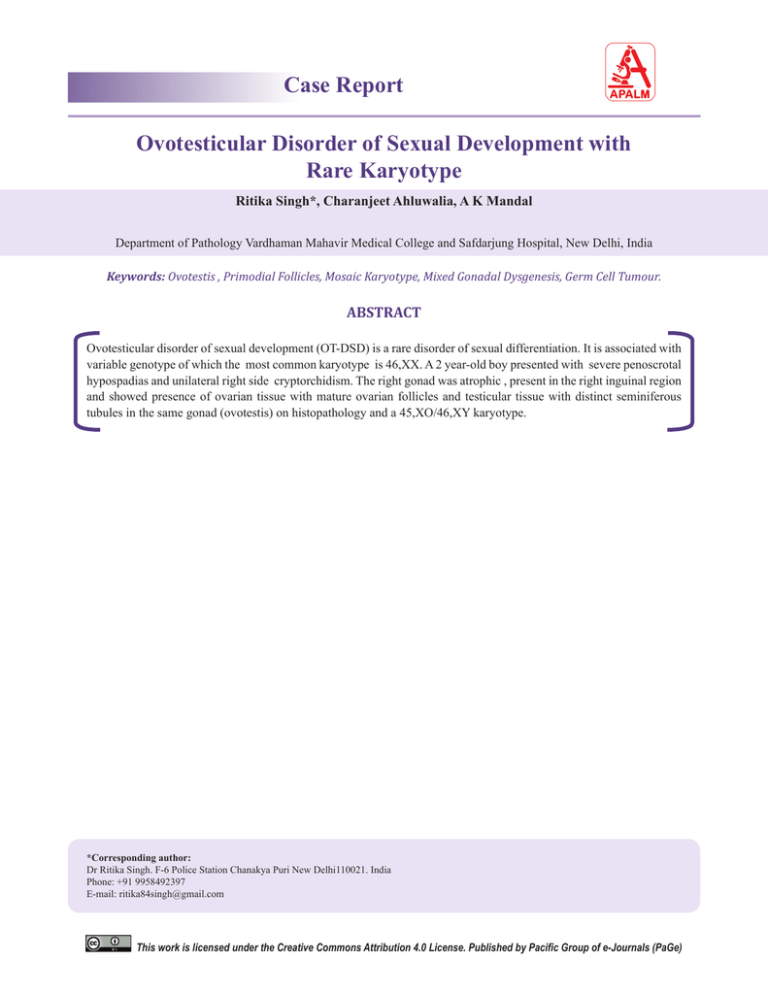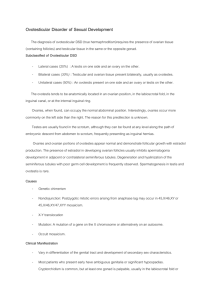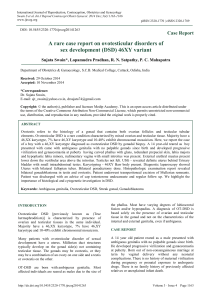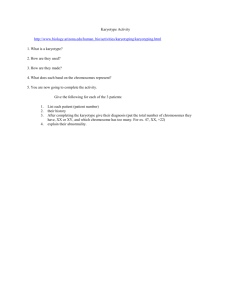
Case Report
Ovotesticular Disorder of Sexual Development with
Rare Karyotype
Ritika Singh*, Charanjeet Ahluwalia, A K Mandal
Department of Pathology Vardhaman Mahavir Medical College and Safdarjung Hospital, New Delhi, India
Keywords: Ovotestis , Primodial Follicles, Mosaic Karyotype, Mixed Gonadal Dysgenesis, Germ Cell Tumour.
ABSTRACT
Ovotesticular disorder of sexual development (OT-DSD) is a rare disorder of sexual differentiation. It is associated with
variable genotype of which the most common karyotype is 46,XX. A 2 year-old boy presented with severe penoscrotal
hypospadias and unilateral right side cryptorchidism. The right gonad was atrophic , present in the right inguinal region
and showed presence of ovarian tissue with mature ovarian follicles and testicular tissue with distinct seminiferous
tubules in the same gonad (ovotestis) on histopathology and a 45,XO/46,XY karyotype.
*Corresponding author:
Dr Ritika Singh. F-6 Police Station Chanakya Puri New Delhi110021. India
Phone: +91 9958492397
E-mail: ritika84singh@gmail.com
This work is licensed under the Creative Commons Attribution 4.0 License. Published by Pacific Group of e-Journals (PaGe)
Singh et al. Introduction
Ovotesticular disorder of sexual development (OT-DSD) is
a rare disorder of sexual differentiation . It is characterized
by the presence of ovarian tissue with mature ovarian
follicles and testicular tissue with distinct seminiferous
tubules in the same gonad (ovotestis).[1] It constitutes
3% – 10% of all sexual disorders. Both Wolffian and
Mullerian duct derivatives are seen, and most affected
individuals commonly present with ambiguous external
genitalia as neonates or infants.[2] In individuals with OTDSD, the ovotestis is the most common histological gonad
type. There is an increased risk of developing germ cell
tumor is the gonads of such individuals.[3,4,5] OT-DSD is
also associated with variable genotype of which the most
common karyotype is 46,XX. [1]
Case Report
A 2 year-old boy presented with severe penoscrotal
hypospadias .Physical examination revealed unilateral
right side cryptorchidism with left gonad palpable in
left hemi scrotum and normal in size. No other physical
abnormality was noted.
Ultrasound examination showed a heterogenous ovoid
structure present in the right inguinal region. Left gonad had
homogenous echotexture .Pelvic ultrasound examination
showed no evidence of a uterus or ovaries. The testosterone
levels were measured both were in the normal range
(3-10ng/ml). Cytogenetic analysis performed on peripheral
blood lymphocytes revealed a 45,XO/46,XY karyotype.
Right sided gonadectomy and hypospadias repair was
performed. The right gonad was submitted along for
histopathological evaluation.
Histopathological findings: Gross examination revealed
a tubular grey white structure measuring 3.5x1x0.5 cms.
Histopathologic examination of the right gonad showed
the ovarian and testicular tissue. Ovarian tissue consisted
of ovarian stroma with primordial follicles along with
ipsilateral fallopian tubal lumen and endometrial stromal
tissue. The testicular tissue consisted of numerous solid
seminiferous tubules filled with immature sertoli cells
and a few primitive germ cells. The immature sertoli cells
had a regular, round to ovoid nucleus with inconspicuous
nucleoli. The germ cells were found adjacent to the
basement membrane and those were distinguishable from
the immature sertoli cells because of their larger nuclei and
abundant cytoplasm. Also identified was vas deferens. A
histopathological diagnosis of ovotestis was given.
A-69
(TH) is the rarest form of intersexuality and the term is
applied to an individual who has both well-developed
ovarian and testicular tissues[6] .It accounts for less
than ten percent of intersex patients.[7]. Krob et al
examined the histopathological structures of the gonads
in 283ovotesticular DSD cases and found that the most
common gonad type was ovotestis (44.4%), followed by
ovary (21%) and testis (12.5%).[5]
Ovotestes are usually compartmentalized, with connective
tissue separating the ovarian components from the testicular
components. However, on rare occasions, an intermixture
of these elements may occur.Testicular tissue in OT-DSD is
defined by the presence of immature seminiferous tubules
lined by immature sertoli cells and primitive germ cells,
and ovarian tissue is defined by the presence of numerous
primordial and/or maturing follicles within the ovarian
stroma.[6]
Various types of chromosomal abnormalities have been
described in OT-DSD with ovotestis such as 46, XX;
46, XY; 46, XX/46, XY, 45, X/46, XY.[5] This diagnostic
nomenclature is applied regardless of the peripheral
karyotype. 45XO/XY is a very rare genotype as reported
in the present case to be associated with ovotestis .The
clinical phenotype associated with 45, X/46,XY mosaicism
is broad, ranging from women, with or without Turner
syndrome stigmata, to apparently normal males, with
intervening variable ambiguous phenotypes[8]. Gonad
histology associated with 45, X/46,XY mosaicism is also
variable with partial, complete, mixed, or asymmetric
gonadal dysgenesis showing streak gonads.[9]
In patients with ovotesticular DSD,the rate of occurrence
of neoplasia is estimated at 2.6% [4] However some studies
estimate that the risk of germ cell tumor development in
OT-DSD ranges from 4% among those with the 46,XX
karyotype to up to 10% in those with 46,XY and 46,XX/
XY chimerism .[10] The removal of the opposite gonad from
the assigned gender and a biopsy of remaining gonadal
tissue for histological evaluation may be appropriate.[6]
Ovotesticular disorder of sexual differentiation formerly
known as true hermaphroditism
Ovotesticular disorder also needs to be differentiated
from mixed gonadal dysgenesis (MGD) with which it
may show histological and genotypic overlapping.MGD
has varying degree of histological presentations such as
streak testis,streak ovaries but unlike OT-DSD maturing
primordial follicles are not identified in gonads of MGD [6].
Also various structural and systemic anomalies which need
early medical attention are seen in patients of MGD unlike
OT-DSD. MGD carries a high risk of tumor development
at 12% and possibly at more than 30% if gonadectomy had
not been performed. In patients with mosaic karyotype
www.pacificejournals.com/apalm
eISSN: 2349-6983; pISSN: 2394-6466
Discussion
A-70
Ovotesticular Disorder with Rare Karyotype
Fig. 1. (a). Ovarian tissue identified in the gonad revealed characteristic ovarian stroma and the
presence of scattered primordial follicles (H&E ×40). (b). Numerous solid seminiferous tubules filled
with immature sertoli cells and a few primitive germ cells along with rudimentary epididymis (H&E
×20). (c). Endometrium and myometrium from the uterine part of gonad (H&E ×20). (d). Fallopian tube
(H&E ×40).
the prevalence ranges between 15 and 40%. [4] Bilateral
gonadectomy is recommended in all individuals with
MGD containing Y-chromosome material.[11] In the present
case no such abnormalities were present supporting the
histological diagnosis OT-DSD.
Conclusion
The most common genotype associated with ovotesticular
DSD is 46,XX . 45,XO/46XY mosaic karyotype is
rarely seen with it. This case highlights the importance
of histological finding in ovotesticular disorder of
sexual development as clinical features, cytogenetic
results, hormonal profiles do not appear to be useful in a
differentiating it from mixed gonadal dysgenesis.
Acknowledgements
Nil
Funding
None
Competing Interests
None
Refrences
1. Sperling MA, editor. Pediatric endocrinology, 3rd
ed.Philadelphia: WB Saunders; 2008:138.
2. Hughes IA, Houk C, Ahmed SF, Lee PA; Lawson
Wilkins Pediatric Endocrine Society/European Society
for Paediatric Endocrinology Consensus Group.
Consensus statement on management of intersex
disorders. J Pediatr Urol .2006;2:148 – 62.
3. Bhansali A, Mahadevan S, Singh R, Rao KL et al. True
hermaphroditism: clinical profile and management of
six patients from North India. J Obstet Gynaecol .
2006;26:348–50.
4.
Pleskacova J, Hersmus R, Oosterhuis JW, Setyawati
BA,et al. Tumor risk in disorders of sex development.
Sex Dev. 2010;4:259–69.
Annals of Pathology and Laboratory Medicine, Vol. 03, No. 02, April - June 2016
Singh et al. 5. Krob G, Braun A, Kuhnle U. True hermaphroditism:
geographical
distribution,
clinical
findings,
chromosomes and gonadal histology. Eur J Pediatr
.1994;153:2– 10.
6. K.-R. Kim et al.Hermaphroditism and Gonadal
Dysgenesis.Mod Pathol. 2002;15:1013-9.
7. Damiani D, Fellous M, McElreavey K, Barbaux S
et al. True hermaphroditism: clinical aspects and
molecular studies in 16 cases. Eur J Endocrinol.
1997;136(2):201-4.
8. Moussaif NE, Haddad NE, Iraqi N, Gaouzi A.
45,X/46,XY mosaicisme: report of five cases and
clinical review. Annales d’Endocrinologie. 2011 ;72:
239–243.
www.pacificejournals.com/apalm
A-71
9.
Ocal M. Berberoglu Z. Siklar et al. The clinical and
genetic heterogeneity of mixed gonadal dysgenesis:
does “disorders of sexual development (DSD)”
classification based on new Chicago consensus
cover all sex chromosome DSD? Eur J Pediatric
.2012;171:1497–1502.
10. Wettasinghe K, Sirisena N, Andraweera P, Jayasekara
R et al. A Case Series of Five Sri Lankan Patients with
Ovotesticular Disorder of Sex Development. Clin
Pediatr Endocrinol. 2012 ; 21(4): 69–73.
11. Hughes IA, Houk C, Ahmed SF, Lee PA. Consensus
statement on management of intersex disorders. Arch
Dis Child .2006;91: 554–63.
eISSN: 2349-6983; pISSN: 2394-6466






